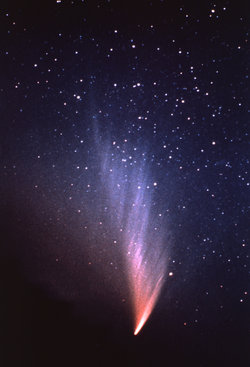Comets

Comets are small Solar System bodies that orbit the Sun and, when close enough to the Sun, exhibit a visible coma (or atmosphere) and/or a tail — both primarily from the effects of solar radiation upon the comet's nucleus. Comet nuclei are themselves loose collections of ice, dust and small rocky particles, measuring a few kilometres or tens of kilometres across.
Comets have a variety of different orbital periods, ranging from a few years, to hundreds of thousands of years, while some are believed to pass through the inner Solar System only once before being thrown out into interstellar space. Short-period comets are thought to originate in the Kuiper Belt, or associated scattered disc,[1] which lie beyond the orbit of Neptune. Long-period comets are believed to originate at a very much greater distance from the Sun, in a cloud (the Oort cloud) consisting of debris left over from the condensation of the solar nebula. Comets are thrown from these outer reaches of the Solar System inwards towards the Sun by gravitational perturbations from the outer planets (in the case of Kuiper Belt objects) or nearby stars (in the case of Oort Cloud objects), or as a result of collisions.
Comets leave a trail of debris behind them. If the comet's path crosses Earth's path, then at that point may be meteor showers as the Earth passes through the trail of debris. The Perseid meteor shower occurs every year between August 9 and 13 when the Earth passes through the orbit of the comet Swift-Tuttle. Halley's comet is the source of the Orionid shower in October.
Comets are distinguished from asteroids by the presence of a coma and/or tail, though very old comets that have lost all their volatile materials may come to resemble asteroids.[2] Asteroids are also believed to have a different origin from comets, having formed in the inner Solar System rather than the outer Solar System.[3] Recent findings have, however, somewhat blurred the distinction between asteroids and comets;[4] see also Asteroid: Terminology.
There are a reported 3,354 known comets as of November 2007,[5] of which several hundred are short-period. This number is steadily increasing. However, this represents only a tiny fraction of the total potential comet population: the reservoir of comet-like bodies in the outer solar system may number one trillion.[6] The number of naked-eye comets averages to roughly one per year,[7] though many of these are faint and unspectacular. When a historically bright or notable naked-eye comet is witnessed by many people, it is often considered a Great comet.
The word "comet" came to the English language through Latin cometes from the Greek word komē, meaning "hair of the head"; Aristotle first used the derivation komētēs to depict comets as "stars with hair." The astronomical symbol for comets (☄) accordingly consists of a disc with a hairlike tail.
Asteroids

Asteroids, also called minor planets or planetoids, are Solar System bodies smaller than planets but larger than meteoroids (which are commonly defined as being 10 meters across or less),[1] and that are not comets. The distinction between asteroids and comets is made on visual appearance when discovered: comets must show a perceptible coma (a fuzzy "atmosphere"), while asteroids do not.
Asteroids vary greatly in size, from a few hundreds of kilometres in diameter down to rocks just tens of metres across. A few of the largest are roughly spherical and are very much like miniature planets. The vast majority, however, are much smaller and are irregularly shaped. The physical composition of asteroids is varied and in many cases poorly understood. Some are solid rocky bodies, with a greater or lesser metallic content, while others are piles of rubble held together loosely by gravity. Only one asteroid—Vesta—is visible to the naked eye, and this only in very dark skies when it is favourably positioned.
The first named minor planet, Ceres, was discovered in 1801 by Giuseppe Piazzi, and was originally considered a new planet.[2] This was followed by the discovery of other similar bodies, which with the equipment of the time appeared to be points of light, like stars, showing little or no planetary disc (though readily distinguishable from stars due to their apparent motions). This prompted the astronomer Sir William Herschel to propose the term "asteroid", from Greek αστεροειδής, asteroeidēs = star-like, star-shaped, from ancient Greek Aστήρ, astēr = star.
The vast majority of known asteroids are found within the main asteroid belt, between the orbits of Mars and Jupiter, generally in relatively low-eccentricity (i.e., not very elongated) orbits. This belt is estimated to contain more than 750,000 asteroids larger than 1 kilometer across, and millions of smaller ones.[3] It is thought that these asteroids are remnants of the protoplanetary disk, and in this region the accretion of planetesimals into planets during the formative period of the solar system was prevented by large gravitational perturbations by Jupiter. Some asteroids have moons or are found in co-orbiting pairs known as binary systems. Minor planets have more recently been found to cross the orbits of planets, from Mercury to Neptune—with hundreds of trans-Neptunian objects (TNOs) now known to exist well past Neptune's orbit. (Using indirect methods, the total number of TNOs has been estimated in the hundreds of millions or even billions.)
Asteroids are given a provisional designation by year in the order of discovery, and a designation (a sequential number) and name if their existence is well established and an orbit has been determined.
